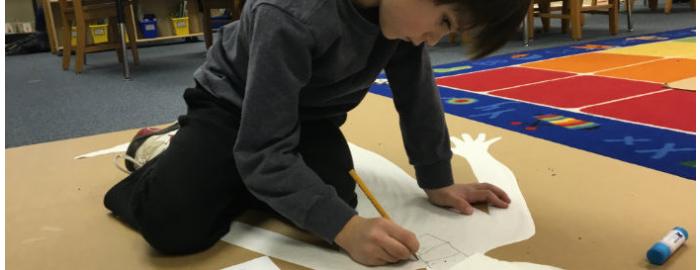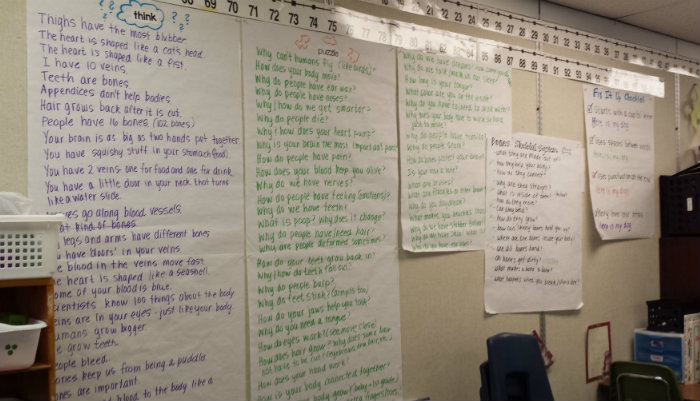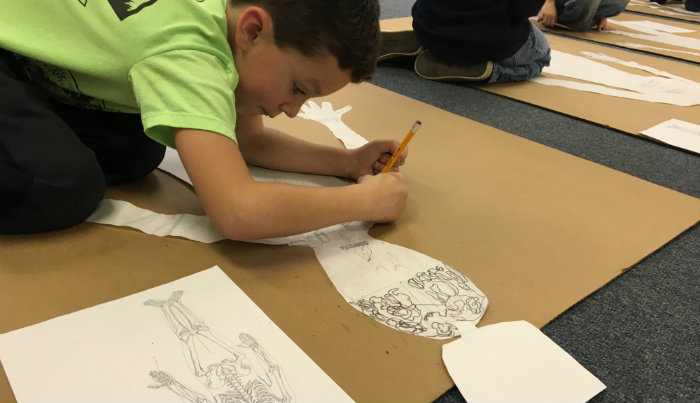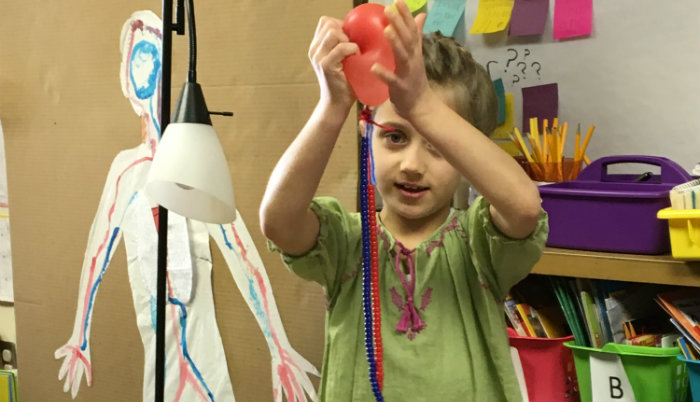
A recent blog covered ESAA’s first grade Exhibition of Learning (EOL) on human body systems. It was a reminder of what The Étude Group’s education philosophies create when they are put into practice. It was also an opportunity for us to step back and acknowledge that this is not an accident. The approach, the successes, the learning…it is purposeful, and it is a process.
ESAA implements a project-based learning creative process that provides a framework for a great deal of the learning at the school. It incorporates aspects of design process, scientific process, and artistic process and includes four main components.
The first essential component is Observing and Discovery. It provides students with the opportunity to create context. As they think, observe, research, read, consult, and discover, the information begins to matter.
How do students begin to understand what to research? Teachers lead thinking routines from Harvard's Project Zero. Students use “wonders, explores, questions” thinking routines to focus their research. Thinking routines are structures to encourage students to look deeper.
Observation and “close looking” build greater understanding and are also critical parts of research. Students are able to use non-fiction texts (print and digital), books, articles, photos, video, art, and music to learn more. Literacy is integrated into the process with reading strategies and group discussions. Ideas are documented through student notes and visible charts. Ultimately, book research and reading provides much of the basis for our reader’s and writer’s workshops.
Our community partnerships allow us to engage professionals who lend their expertise and experiences with our students as they develop their ideas during observing and discovery.
Charts with questions, resource books, and student notes were prominent on the walls and tables during the first grade EOLs on body systems. Students spoke of their research and reading during their presentations. The documentation of observing and discovery was evident.
The second essential component is Creating. Students are given a voice and a choice when developing their plan and while revising. ESAA uses a feedback loop that includes making, feedback, and revising. Students make their plan and document their ideas, share their ideas with peers and their teacher, and make revisions based on feedback and new information.
The school’s use of a “Ladder of Feedback” ensures that students receive feedback in a constructive and consistent way. Other students ask clarifying questions followed by value statements that share what they appreciate in the work that has already been completed. Concerns are voiced through “I wonder…” statements and “Have you considered…” questions. Finally, students receive suggestions for addressing concerns.
Students further develop their ideas, make modifications, and get feedback as they create. Teachers conference with students and groups throughout this phase. Mistakes are opportunities for improvement and learning.
Our first graders created plans to turn their research into 3-D models of body systems. They made revisions based on feedback and experiences. They were allowed to make choices as their ideas became plans, and they created their final products.
The third step in the project-based learning creative process is for students to Present. It is critical for students to document and communicate what they have learned. For our students at The Étude Group, this includes the Exhibition of Learning. Students rehearse their EOLs with buddy classes. They receive feedback on their presentations but also questions on their process and work. Again, feedback plays an important part of learning.
Like our first graders and their body systems projects, students at ESAA make presentations to parents and others on the process of their learning, their projects, and final products. Presentations allow students to assess their own learning, demonstrate learning that may not be shown in standardized tests, build community, and provide students with even deeper learning.
Essential to all aspects of this creative process is the fourth component, Reflection. Students must reflect on what is going well and where they have opportunities for improvement and growth. They use reflection journals and thinking routines to guide them. Ultimately student reflections on the process, product, and Exhibition of Learning become the student’s Presentation of Learning, our student-led conferences.
It would be a mistake to believe that providing this type of learning experience is easy or offered in isolation. Educators work as teams to incorporate the creative process and the project in all subjects. This was evidenced with our first graders and the expansion of their projects into music and movement.
Our staff attend professional development workshops, collaborate as teams, and develop deep understandings of the research supporting the project-based learning creative process. The Ladder of Feedback, Habits of Mind, Habits of Professionalism, and thinking routines are the processes and language all of our educators use and our students understand. Our students, from kindergarten through 12th grade, benefit from the consistency of this process and consistently great, project-based education.
The same quality, collaborative, creative project-based learning is taking place throughout each school in The Etude Group. Students at Mosaic and IDEAS Academy learn in community that encourages discovery and development of their creative potential.
Our students:
-
Develop creative / innovative thinking through authentic, disciplinary projects
-
Value a culture that promotes thinking
-
Become independent, self-directed learners
-
Build a connected, participatory community
-
Actively prepare for college and career
Educators at The Étude Group aren’t teaching students who can churn out facts. They are guiding thinkers; students who will become adults that can approach a situation, acknowledge what they may know, discern the quality of new information being presented, establish a context for their new knowledge, and solve problems. Our students are learning how to learn.




